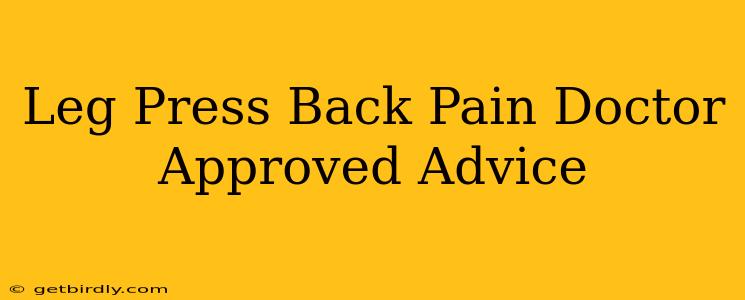Leg Press Back Pain? Doctor-Approved Advice
Feeling back pain after using the leg press machine? You're not alone. Many people experience this, and it's crucial to understand why it happens and how to prevent it. This article provides doctor-approved advice to help you conquer leg press back pain and safely build leg strength. We'll explore common causes, preventative measures, and modifications to your technique.
Why Does My Back Hurt After Leg Pressing?
Back pain after leg pressing often stems from improper form and technique. Let's delve into the most common culprits:
-
Arched Back: This is the most frequent cause. When your lower back arches excessively during the leg press, it places significant stress on your spine, leading to pain. This is because the muscles responsible for supporting your lower back (erector spinae) are overworked.
-
Poor Posture: A rounded or slumped posture can also contribute to back pain. This misaligns your spine and puts undue pressure on the vertebrae.
-
Incorrect Foot Placement: Placing your feet too high or too low on the platform alters the biomechanics of the exercise, increasing strain on your back.
-
Overweighting: Lifting weights that are too heavy for your current strength level increases the risk of injury and back pain. Your body compensates for the extra weight, often resulting in improper form.
-
Pre-existing Conditions: Underlying conditions like spinal stenosis, herniated discs, or sciatica can exacerbate back pain during leg pressing.
-
Weak Core Muscles: A weak core is unable to provide adequate stabilization during the exercise, leaving your spine vulnerable to injury.
What Should I Do If I Have Back Pain After Leg Pressing?
If you experience back pain after a leg press workout, here's what you should do:
-
Rest: Allow your body time to recover. Avoid any strenuous activity that aggravates the pain.
-
Ice and Heat: Apply ice packs to reduce inflammation during the first 24-48 hours. After that, consider using heat therapy to relax sore muscles.
-
Over-the-Counter Pain Relief: Non-steroidal anti-inflammatory drugs (NSAIDs) like ibuprofen or naproxen can help manage pain and inflammation. Always follow the recommended dosage and consult your doctor or pharmacist if you have any concerns.
-
Stretching: Gentle stretching can help alleviate muscle tightness and improve flexibility. Focus on stretches for your lower back, hamstrings, and hips.
-
Consult a Doctor or Physical Therapist: If the pain persists or is severe, seek professional medical advice. A physical therapist can assess your form, identify any underlying issues, and create a personalized rehabilitation plan.
How Can I Prevent Back Pain When Leg Pressing?
Prevention is key! Here's how to modify your leg press technique to minimize the risk of back pain:
-
Maintain a Neutral Spine: Keep your lower back pressed firmly against the backrest throughout the entire movement. Avoid arching or rounding your spine.
-
Proper Foot Placement: Position your feet shoulder-width apart, slightly lower on the platform. Experiment to find the optimal placement that minimizes back strain.
-
Controlled Movements: Perform the leg press with slow, controlled movements. Avoid jerky or abrupt motions.
-
Warm-up: Always warm up your muscles before starting your leg press workout. This prepares your muscles for the exercise and reduces the risk of injury.
-
Progressive Overload: Gradually increase the weight you lift over time. Avoid increasing weight too quickly, which can lead to poor form and injury.
-
Strengthen Your Core: A strong core is crucial for spinal stability. Incorporate core strengthening exercises into your routine. Planks, bridges, and Russian twists are great options.
What Exercises Can I Do Instead of the Leg Press if My Back Hurts?
If you're experiencing persistent back pain from the leg press, consider alternative exercises that target the same muscle groups with less spinal stress:
-
Glute Bridges: A great alternative for building glute strength.
-
Squats (with proper form): Focus on maintaining a neutral spine and proper depth.
-
Leg Extensions: Isolates the quadriceps, reducing stress on the back.
-
Hamstring Curls: Works the hamstrings, leaving your back relatively uninvolved.
Can I Still Leg Press If I Have Back Pain?
This depends entirely on the severity and nature of your back pain. If you experience sharp, shooting pain, or pain that radiates down your leg, stop leg pressing immediately and seek professional medical help. If your pain is mild and only occurs after the workout, you may be able to continue, but only after making crucial adjustments to your form, weight, and possibly incorporating preventative measures outlined above.
Conclusion
Leg press back pain is common, but preventable. By focusing on proper form, warming up adequately, strengthening your core, and listening to your body, you can significantly reduce your risk of injury and continue to build leg strength safely. Remember, if you have persistent or severe pain, consulting a healthcare professional is vital. They can provide accurate diagnosis and guidance tailored to your specific needs.

